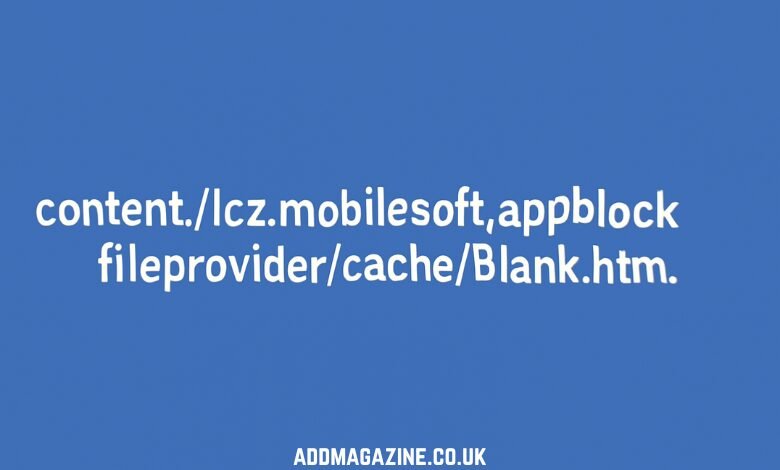In the world of Android development, resources such as images, videos, or files often need to be accessed or shared between different apps. One of the mechanisms that make this possible is Android’s Content Providers. If you’re navigating through an app like AppBlock, you may come across URLs like content://cz.mobilesoft.appblock.fileprovider/cache/blank.html. This article will break down what this specific URL means, its purpose, and the role of Android’s content provider system in handling app resources efficiently.
What is content://cz.mobilesoft.appblock.fileprovider/cache/blank.html?
At its core, this URL represents a content URI, which is part of Android’s content provider system. To understand what this URL means, we need to break it into components:
- content:// – This is the protocol indicating the use of Android’s content provider mechanism. Android uses content providers to allow one app to access data from another app, like retrieving contact information, images, or even files from storage. The
content://URI indicates that the app is interacting with a piece of content that is stored or managed by a content provider. - cz.mobilesoft.appblock – This is the unique identifier for the app that owns the content. In this case, it refers to AppBlock, an app designed to help users block distracting apps or websites to improve focus. The package name uniquely identifies the app within the Android ecosystem.
- fileprovider – This component indicates that the app is using the FileProvider class in Android, a secure mechanism for sharing files between apps. FileProvider is typically used to give other apps access to files stored on the device without exposing the app’s private internal storage.
- /cache/blank.html – The file in question,
blank.html, is stored in the cache directory of the app. Cache is used to store temporary files that are not meant to be persistent but can help speed up access to certain content, such as images or HTML files that the app needs to load quickly. Theblank.htmlfile is likely a placeholder or a temporary file that serves some internal purpose in the app.
How Does the Content Provider System Work?
In Android, the Content Provider is an essential component that allows data sharing between apps. For example, you might have an app that manages contacts or calendars. Rather than giving direct access to your app’s private data, Android uses Content Providers to offer a controlled way for apps to request and receive this data. A Content URI like the one we’re analyzing in this article allows secure and standardized access to files or data.
Content providers use a system of URIs to expose specific content from an app’s storage to other apps. In the case of the content://cz.mobilesoft.appblock.fileprovider/cache/blank.html URL, it means that AppBlock is providing access to the blank.html file in its cache directory. However, this is only possible if the app explicitly allows other apps or system services to access this file using the appropriate permissions.
Why Is the blank.html File Important?
Now that we know the basics of the content URI system, what role does the blank.html file play in this scenario? Let’s break it down:
- Temporary Use: The
blank.htmlfile is likely part of the app’s temporary cache. Cache files are typically used to store data that doesn’t need to persist between app sessions but helps the app perform its functions more efficiently. For instance, if AppBlock needs to load a temporary HTML page to display a loading screen, a blank HTML file could serve as a placeholder while the app loads content. - Placeholder or Template: HTML files are commonly used for displaying content in Android apps, and the
blank.htmlfile may be a template that gets filled with content dynamically. It could serve as a skeleton structure for a webpage that the app needs to display temporarily. - Privacy and Security: Since the file is stored in the cache, it is likely not meant to be accessed by the user directly. Android’s content provider mechanism ensures that files like
blank.htmlare only accessed through authorized channels, making the data more secure.
What Does This Mean for Users?
For most users, URLs like content://cz.mobilesoft.appblock.fileprovider/cache/blank.html won’t mean much in day-to-day usage. These URLs are part of the inner workings of the app, helping it function efficiently without the user needing to interact with them directly. However, there are a few things users should know:
- App Performance: Cache files, including HTML files like
blank.html, can help improve the performance of an app. They allow apps to load content faster by storing temporary files that can be reused when needed. - Privacy Considerations: Content providers help ensure that app data is shared securely. This means that files and information are not exposed without permission, making it a safe way for apps to handle sensitive or temporary data.
- Troubleshooting: If you encounter issues with an app like AppBlock, such as slow loading times or errors, understanding the role of cache files might help. Clearing the cache might resolve some issues if the app is storing outdated or corrupt files.
How Android’s FileProvider Enhances Security
Android’s FileProvider class is designed to enhance security when accessing shared files. It allows apps to share files without exposing their private internal storage. This is critical in maintaining the privacy and integrity of user data.
For instance, if an app needs to share a file, instead of directly giving access to the file system, it generates a content URI that is exposed to other apps. The receiving app can only access the file if it has the appropriate permissions, ensuring that only authorized apps can access sensitive files. This makes it much safer than simply sharing file paths.
Best Practices for Developers Using Content Providers
If you’re a developer using Android’s Content Provider system, here are some best practices to ensure secure and efficient data sharing:
- Use Content URIs for Secure File Sharing: Always use content URIs to share files between apps rather than directly exposing file paths. This ensures that apps interact with shared content in a secure manner.
- Implement Permissions Carefully: Be mindful of the permissions you request from users and other apps. Only expose content that is necessary, and ensure that other apps have the appropriate permissions to access sensitive data.
- Clear Cache Regularly: Cache files, like the
blank.htmlfile, are not meant to persist long-term. Regularly clearing the cache can help free up storage space and prevent issues with outdated data. - Avoid Storing Sensitive Data in Cache: Cache is not a secure place to store sensitive data. Use more secure storage solutions like Android’s Keystore for sensitive information, such as passwords or personal data.
The Role of Cache in Android Apps
Cache plays a significant role in the performance optimization of mobile applications, including apps like AppBlock. Android apps often rely on cache to store data temporarily, speeding up operations and enhancing user experience. In many cases, cache data can include a variety of content such as images, HTML files, or even entire pages that the app needs to access quickly. For example, in the case of content://cz.mobilesoft.appblock.fileprovider/cache/blank.html, the file is stored in the cache directory and is used to help render a temporary blank page, often during transitions, loading screens, or placeholders before the app loads content dynamically.
How Cache Improves App Performance
- Speed and Efficiency: By using cache, Android apps can avoid repeatedly downloading or processing data that doesn’t change frequently. Cached data can be accessed faster than fetching it from the network or database each time. For apps like AppBlock, cache allows for quicker display of content like settings pages or temporary data that doesn’t need to be reloaded from scratch every time.
- Reduction in Network Usage: Since cache allows the app to store resources locally, it reduces the need for network calls for data that remains unchanged. This is especially useful for apps that deal with repetitive content or data that doesn’t need constant updates, like blocking websites or apps, where certain data remains static for a while.
- User Experience: From a user perspective, caching helps in providing smoother experiences. For instance, when users switch between different screens or navigate through the app, caching helps avoid delays caused by re-fetching resources, making the app feel faster and more responsive.
Risks and Challenges of Cache
While cache can significantly improve app performance, it also comes with potential risks and challenges:
- Outdated Data: If an app’s cache isn’t cleared or updated regularly, it might serve outdated or incorrect content. This can lead to user frustration or errors within the app, especially if a new version of the app modifies the underlying content.
- Storage Space: Cache files can take up significant space on a user’s device over time. If an app’s cache is not managed properly (e.g., by clearing old or unused files), it could lead to performance issues or even fill up the device’s storage, affecting the device’s overall performance.
- Security Risks: Storing sensitive information in cache can expose that data to unauthorized access, especially if it isn’t encrypted or properly secured. It’s essential that developers avoid storing sensitive user data, like passwords or private information, in cache to prevent unauthorized access in case the app’s cache is exposed.
Clearing Cache for Performance Optimization
For both users and developers, regularly clearing the cache is crucial for maintaining optimal app performance. Here are some considerations when managing cache:
- Automatic Cache Clearing: Many apps, including AppBlock, may automatically clear cached data when it becomes unnecessary or when the app is uninstalled. Developers should implement a mechanism that removes old cache files after they’re no longer required.
- User Control: Providing users with an option to clear cache manually can be a helpful feature. Sometimes, users may face issues such as slow loading or outdated content due to a bloated cache. Allowing them to clear it can resolve these issues and improve app speed.
- Avoid Storing Sensitive Data in Cache: As mentioned, cache should never be used for sensitive data. Developers should ensure that only non-sensitive, temporary information is stored in cache. For example, the
blank.htmlfile is likely safe as it is just a placeholder, but storing user preferences, passwords, or other private information in cache could lead to data security issues.
The Evolution of Content Providers in Android Development
Android has evolved significantly over the years, and so has the use of Content Providers. Originally, content providers were used primarily for sharing simple data like contacts or media files across different apps. However, as Android apps became more complex, content providers started handling more intricate interactions, such as managing large sets of data, syncing content, or sharing app-specific files in a more controlled manner.
The introduction of FileProvider specifically addressed the need for sharing files between apps. By securely generating content URIs, FileProvider prevents unauthorized access to the app’s private storage while still enabling data sharing. This feature has greatly enhanced the security and privacy of apps, preventing potential data leakage through unsecured file paths.
Furthermore, with the increasing adoption of cloud storage and online syncing, Android’s content provider system has become more integral to modern app development. Content Providers now handle data synchronization, allowing apps to share not just local files but also cloud-based resources, ensuring that users have access to their data from anywhere.
How Developers Can Leverage Content Providers
If you’re a developer, understanding how to effectively use content providers is essential for creating secure, efficient, and feature-rich Android apps. Here are some key steps to implement content providers and FileProvider in your apps:
- Implement a Secure Content Provider: When creating a content provider, ensure that you properly secure the data being shared. This involves defining the appropriate permissions to prevent unauthorized access to sensitive data. Be mindful of who can access your content provider and how it is being shared.
- Use FileProvider for Secure File Sharing: If you need to share files between apps, consider using FileProvider. It generates content URIs that give access to specific files while maintaining security, meaning you don’t have to expose the app’s internal file paths to other apps.
- Cache Management: Efficient cache management is crucial for maintaining app performance. Implement proper cache expiration policies, and periodically clear cache files that are no longer necessary. You can even give users the option to clear cache manually, which can help improve performance on their devices.
- Monitoring and Optimization: Monitor the usage of content providers and cache in your app. If you notice that the app is consuming excessive resources, it may be time to optimize the way it handles cached data or shared files. Performance monitoring tools can help you identify areas for improvement.
The Future of Content Providers and Cache Management
As Android continues to evolve, so will the ways apps handle content and data. The introduction of Jetpack libraries, such as Room for local data storage and WorkManager for background tasks, offers developers more streamlined and efficient ways of managing content and cache. These modern tools ensure that apps are not only secure and responsive but also adhere to the best practices of managing data.
With the growing importance of data privacy and security, Android is likely to implement even stricter guidelines for using content providers, especially in the context of sharing personal information and handling user data. Developers will need to stay updated with the latest security protocols and best practices to ensure they are compliant with data protection regulations like GDPR and CCPA.
In the future, cache management will likely become more automated, with Android offering tools to better handle cache cleanup and data optimization. Developers may also gain more flexibility in controlling how data is cached, making it easier to create efficient, performance-optimized apps.
Conclusion
In summary, content://cz.mobilesoft.appblock.fileprovider/cache/blank.html is a content URI used by the AppBlock app to access a temporary file stored in its cache. It is part of Android’s content provider system, which allows secure and structured sharing of files and data between apps. For most users, this URL will go unnoticed, but understanding its role can help troubleshoot app issues and improve your overall understanding of how Android apps manage resources.
For developers, it’s crucial to understand the best practices for using content providers, ensuring that data sharing is secure and that cache files are used efficiently. By following these guidelines, developers can create more efficient, secure, and user-friendly Android applications.




